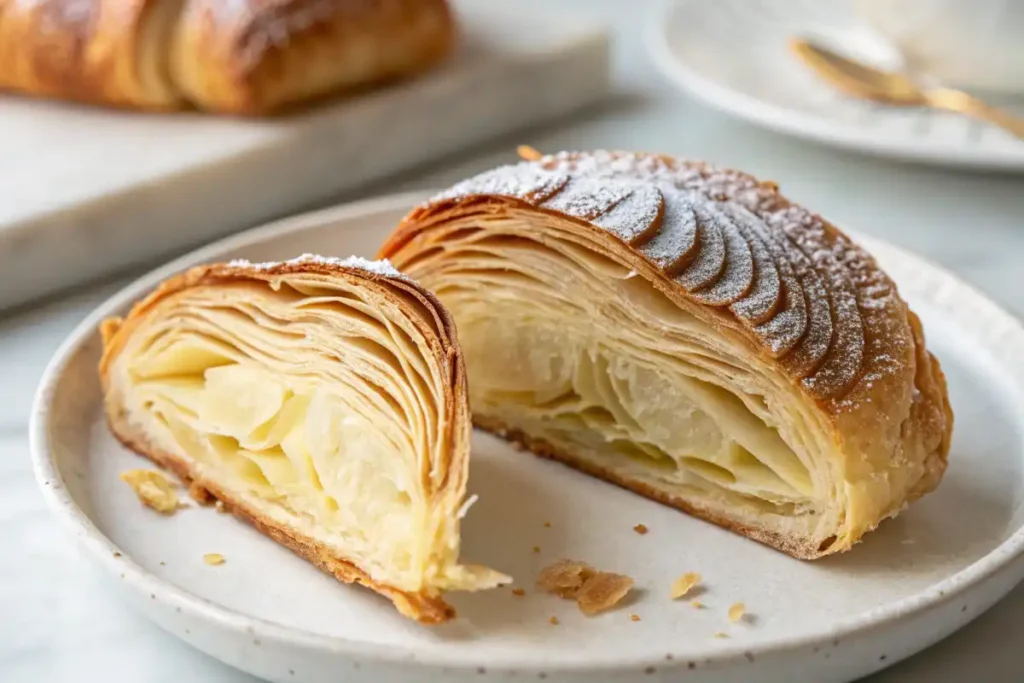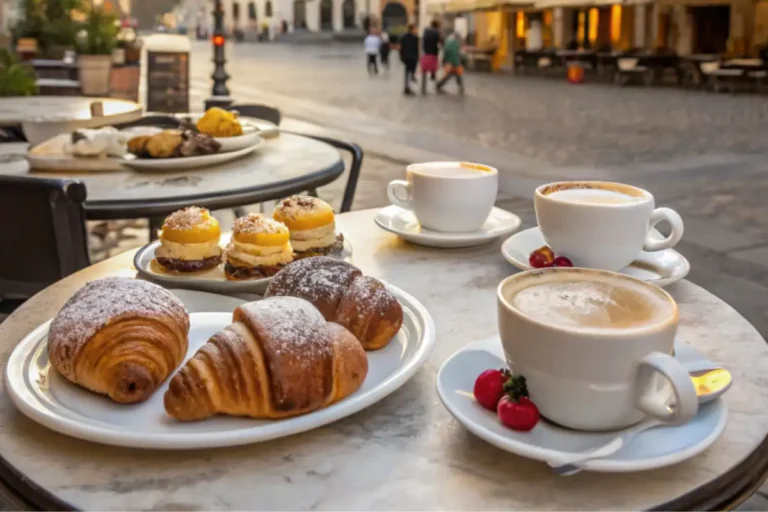Introduction
What are some pastries that Italians eat for breakfast? If you’ve ever strolled through an Italian piazza at dawn, you may have caught a glimpse of locals enjoying a light, yet delicious, pastry with their morning coffee. In Italy, breakfast is a ritual that celebrates simplicity and quality. Italian pastries are steeped in history and regional traditions, offering a unique culinary experience that goes far beyond the typical American doughnut or croissant.
In this comprehensive guide, we will explore five of the best Italian breakfast pastries, delving into their origins, ingredients, and the cultural significance behind each one. Whether you’re planning a visit to Italy, craving a taste of la dolce vita in the U.S., or simply curious about Italian breakfast traditions, you’re in the right place. Get ready to embark on a delicious journey through Italy’s beloved morning treats!
1. Italian Breakfast Culture: A Brief Overview
Italian breakfast is a far cry from the heavy, meal-like mornings found in many other cultures. Italians tend to favor a light start to their day, often featuring a freshly brewed espresso or cappuccino paired with a sweet pastry. This practice reflects the Italian emphasis on quality over quantity and the importance of savoring every moment.
Unlike the U.S. where breakfasts can be hearty with eggs, bacon, and toast, the Italian morning ritual is centered on enjoying a small yet exquisitely crafted pastry that perfectly complements the bold flavor of Italian coffee. This tradition is not just about food; it’s about embracing a lifestyle that values slow mornings and mindful indulgence.
2. Exploring the Popular Italian Breakfast Pastries
Italian pastries are as diverse as the regions they come from. From the buttery layers of a cornetto to the delicate crispiness of a sfogliatella, each pastry tells a story of regional ingredients, local customs, and centuries-old recipes. In this section, we will dive deep into five of the most iconic Italian breakfast pastries.
Cornetto: The Italian Croissant
No discussion of Italian breakfast pastries is complete without mentioning the cornetto. Similar to the French croissant, the cornetto is a staple in Italian cafés. However, it has its own unique twist—a softer, sweeter dough that is often filled with jam, custard, or chocolate.

The origins of the cornetto can be traced back to the early 20th century when Italians began adapting French baking techniques to suit local tastes. Today, the cornetto is celebrated for its tender crumb and delicate layers, which perfectly complement a rich espresso.
Many Italians prefer their cornetto lightly toasted and dusted with powdered sugar. It is not uncommon to see them paired with a fresh squeeze of orange juice or a small glass of milk, making it a versatile treat for any time of the day.
Sfogliatella: A Neapolitan Masterpiece
Sfogliatella, often referred to as the “lobster tail” due to its unique shape, is a pastry that originated in Naples. Its name comes from the word “sfoglia,” meaning “leaf” in Italian, which perfectly describes its many delicate, crispy layers.
This pastry is filled with a mixture of ricotta, semolina, and candied fruit, giving it a rich flavor profile that balances sweet and savory notes. The sfogliatella is a true work of art, requiring skill and precision to achieve its signature texture.

Often enjoyed with a shot of espresso, sfogliatella has become synonymous with Neapolitan pride and culinary excellence. Its intricate design and delicious filling make it a must-try for anyone interested in authentic Italian flavors.
Bombolone: The Italian Doughnut Delight
Bomboloni are the Italian answer to doughnuts, but they come with a twist. These light, fluffy pastries are typically filled with custard, jam, or chocolate and are dusted with sugar. Unlike their American counterparts, bomboloni are enjoyed warm and fresh from the fryer.
The secret to a perfect bombolone lies in the dough—a combination of flour, eggs, sugar, and yeast that is allowed to rise slowly, creating a soft and airy texture. Once fried to golden perfection, these doughnuts offer a satisfying crunch on the outside and a melt-in-your-mouth interior.
Bomboloni are particularly popular during festive seasons but are enjoyed year-round in many Italian cafés. They are a delightful treat that captures the spirit of Italian indulgence without overwhelming the senses.
Maritozzo: Rome’s Cream-Filled Treasure
Hailing from Rome, the maritozzo is a sweet bun traditionally filled with whipped cream. Its origins date back to ancient Roman times, and it has evolved over the centuries to become a beloved breakfast pastry.
The maritozzo is characterized by its soft, pillowy dough that is lightly sweetened and perfectly balanced by the rich, creamy filling. Often enjoyed alongside a cappuccino, this pastry offers a delightful contrast between the light bread and the luxurious cream.
This treat is more than just a pastry; it is a symbol of Roman culinary ingenuity. Modern variations now include additional fillings such as chocolate or almond paste, yet the classic whipped cream version remains a timeless favorite.
Zeppole: A Lesser-Known Regional Gem
Zeppole are another traditional Italian pastry that you might encounter at breakfast time, especially in certain regions during festive periods. These light, airy fritters are often sprinkled with sugar and sometimes dusted with cinnamon.
Originating from Southern Italy, zeppole are made from a simple dough that is deep-fried until it develops a crisp exterior. While commonly associated with celebrations like St. Joseph’s Day, zeppole have also found their place as an occasional breakfast treat, enjoyed with a cup of strong coffee.
The charm of zeppole lies in their simplicity. They remind us that even the most basic ingredients can create something extraordinary when crafted with care and tradition.
3. Traditional Ingredients and Preparation Techniques
Italian breakfast pastries are celebrated not only for their taste but also for the quality of their ingredients. The secret behind these delectable treats lies in using only the freshest, locally sourced products. Flour, eggs, milk, butter, and sugar are combined in precise measures to create the perfect dough and filling.
Many Italian recipes have been passed down through generations, each family adding its own twist to the traditional methods. Whether it’s the slow fermentation of the dough or the careful layering of pastry sheets, every step is taken with love and attention to detail.
The art of pastry-making in Italy is a blend of science and passion. Bakers often use time-tested techniques, such as hand-kneading and natural leavening, to ensure that the final product is as light and flavorful as possible.
4. Regional Variations: Exploring Italy’s Diverse Flavors
Italy’s rich regional diversity is vividly reflected in its breakfast pastries. Each region brings its own local ingredients, culinary traditions, and baking techniques to the table. This means that a pastry you enjoy in Naples might differ significantly from one found in Rome or Milan.
In Northern Italy, pastries often lean towards a more refined, delicate flavor profile. Here, you might find lighter doughs and subtle fillings that emphasize the natural flavors of high-quality butter and cream. Conversely, Southern Italy offers bolder tastes, with pastries that incorporate citrus, almonds, and even hints of spice.
This regional diversity not only enriches the Italian breakfast experience but also provides a fascinating glimpse into the country’s culinary heritage. Each bite is a journey through Italy’s varied landscapes and traditions.
5. Modern Twists on Traditional Italian Pastries
While tradition remains at the heart of Italian pastry-making, modern bakeries and chefs are reimagining these classics for today’s palate. Contemporary twists include fusion flavors, innovative presentations, and even healthier alternatives that cater to modern dietary preferences.
For instance, some bakeries in the U.S. now offer gluten-free versions of the cornetto and bombolone without compromising on taste or texture. Others experiment with unconventional fillings like pistachio cream or matcha-infused custard, infusing a modern edge into time-honored recipes.
These creative reinterpretations allow Italian pastry traditions to evolve while still honoring their origins. The result is a delightful blend of old and new—a celebration of heritage and innovation that appeals to a diverse range of taste buds.
6. Tips for Enjoying Italian Breakfast Pastries in the U.S.
If you’re in the U.S. and craving an authentic Italian breakfast experience, you’re in luck. Many cities boast Italian bakeries and cafés that bring the genuine taste of Italy right to your doorstep. Here are some practical tips to help you enjoy these pastries like a true Italian:
Seek out authentic Italian cafés: Look for local bakeries that specialize in Italian pastries. Often, these establishments import ingredients or follow traditional recipes that have been perfected over decades.
Pair with quality coffee: The Italian breakfast is incomplete without a perfectly brewed espresso or cappuccino. Many Italian cafés take great pride in their coffee, so choose a spot known for its high-quality brews.
Experiment at home: If you can’t find an authentic bakery nearby, try making these pastries at home. There are numerous recipes available that walk you through the traditional techniques. This can be a fun way to explore Italian culinary traditions and impress your friends with a homemade Italian breakfast spread.
Visit during Italian festivals: Many cities host Italian festivals that feature traditional food stands, including bakeries selling fresh pastries. These events are perfect for sampling a variety of treats while enjoying live Italian music and culture.
7. Frequently Asked Questions (FAQs)
What pastries do Italians have for breakfast?
Italians typically enjoy light, sweet pastries for breakfast. The most popular include the cornetto (a pastry similar to a croissant), sfogliatella, bombolone, maritozzo, and regional specialties such as zeppole. These treats are usually paired with a strong coffee, forming a balanced yet delightful morning ritual.
What are traditional Italian pastries?
Traditional Italian pastries are baked goods that have been crafted using time-honored recipes and locally sourced ingredients. Examples include the flaky, buttery cornetto, the layered and filled sfogliatella, and the soft, cream-filled maritozzo. These pastries not only reflect Italy’s rich culinary heritage but also the regional diversity found across the country.
What is served at an Italian breakfast?
An Italian breakfast is typically light and sweet. It usually consists of a freshly brewed espresso or cappuccino accompanied by a pastry such as a cornetto or sfogliatella. Some Italians might also enjoy a biscotti or a small slice of cake, but the emphasis is always on a modest, flavorful start to the day.
What is a famous Roman breakfast pastry?
A famous Roman breakfast pastry is the maritozzo. This sweet bun, traditionally filled with whipped cream, is a beloved treat in Rome. Its soft texture and rich filling make it a perfect accompaniment to a morning coffee, encapsulating the essence of Roman culinary tradition.
Conclusion: Embrace the Italian Morning Ritual
Italian breakfast pastries are more than just a quick bite to start your day—they are a celebration of culture, tradition, and culinary artistry. From the delicate layers of a sfogliatella to the soft, cream-filled maritozzo, each pastry tells a story of Italian heritage and passion for quality ingredients.
As you explore these delightful treats, whether at an authentic Italian café or by trying your hand at homemade recipes, you will discover that the Italian breakfast is truly a feast for the senses. So why not start your day with a touch of Italy? Embrace the tradition, savor the flavors, and share your experience with friends and family.
We invite you to try one or all of these iconic pastries and let your taste buds experience a journey through Italy’s rich culinary landscape. Enjoy your breakfast, and remember, every bite is a celebration of la dolce vita!

